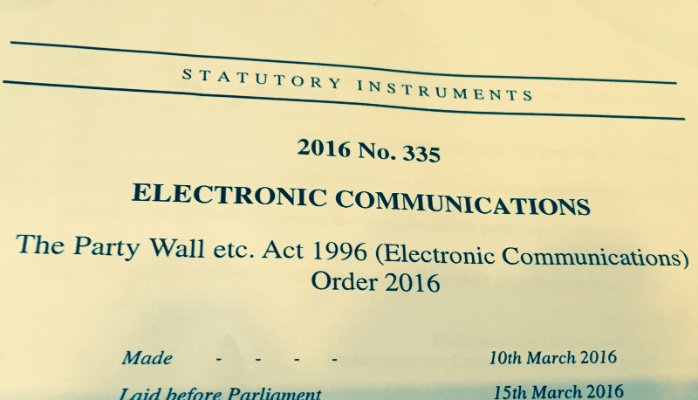The Party Wall etc. Act 1996 (Electronic Communications) Order 2016
From 6th April 2016 the above order – SI 2016/335 (“the Order”) amends the Party Wall etc. Act 1996 (“the Act”) so as to explicitly permit the service of documents under the Act by e-mail, or indeed, for those who still use it, by fax. What does the Order do, how will it alter practice, and how can it be used most effectively?
Paragraph 2 of the Order inserts three new subsections into section 15 of the Act. The full text of the Order can be seen here. It permits a notice or other document required or authorised to be served by the Act – initial notices, counter-notices, requests for security, accounts and, most importantly, awards – to be served by e-mail.
Throughout this article I refer to e-mail, since this is now the most common form of electronic communication, but service is permitted by any form of electronic communication defined by section 15 of the Electronic Communications Act 2000, which would also include faxes.
There are, however, important limitations on the right to serve by e-mail. The recipient must have “stated a willingness to receive the notice or document by means of an electronic communication”, must not have withdrawn that statement, and the notice or document must be sent to an address specified by the recipient.
I would hope that party wall surveyors and their appointing owners, who commonly communicate primarily by e-mail, will adopt the provisions of the Order with some enthusiasm, and that it will be common for building owners and adjoining owners, on the advice of their appointed party wall surveyors, to state a willingness to accept service on such a basis.
In practice, if building owners or their surveyors are in e-mail contact with adjoining owners, then they can simply ask if the adjoining owner is willing to be served with party wall notices and other documents by e-mail.
If there is no such communication, then it would make sense for initial notices (under sections 1, 3 or 6) to be served in the traditional way, usually by post, but for the usual wording of the acknowledgement to be altered so as to give the recipient the opportunity to receive subsequent documents by e-mail, i.e. “I am willing to receive any notice or other document required or authorised to be served under the Act to be sent to me at …. [please insert e-mail address]”.
Building owners, who are usually in the position of trying to push forward the party wall process, will almost certainly be willing to accept service by e-mail. Consequently their initial notice(s), or the covering letter accompanying such notice(s), should state their willingness to accept such service, giving their e-mail address for that purpose.
There are a number of obvious questions which party wall surveyors and appointing owners will want answering about the Order: When will service be effected? What if the e-mail is treated as spam by the recipient’s e-mail software? What if the document being sent is larger than that permitted by the recipient’s e-mail account? Are signatures required on notices and awards, electronic or otherwise? I will endeavour to publish a further post dealing with such questions (and any others readers want to put to me) in the next week or two.
